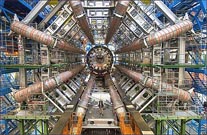Repair plan for ‘Atom Smasher’ being finalized
 London, Oct 30: A repair plan for the Large Hadron Collider (LHC), the world’s most powerful particle accelerator located at CERN, near Geneva in Switzerland, is close to being finalized by physicists.
London, Oct 30: A repair plan for the Large Hadron Collider (LHC), the world’s most powerful particle accelerator located at CERN, near Geneva in Switzerland, is close to being finalized by physicists.
After an electrical fault destroyed part of the LHC and caused several tonnes of liquid helium to leak into the tunnel on September 19, the machine has been out of commission.
The incident damaged up to 29 of the LHC’s superconducting magnets and contaminated the ‘beam pipe’ that carries protons around the collider’s ring.
According to a report in Nature News, physicists hope to have the machine repaired and ready for first collisions by May or June 2009.
But for that to happen, simply replacing the damaged magnets will not be enough. Physicists and engineers at CERN must also ensure that a similar accident cannot occur in the future.
The physicists investigating the failure are focusing on a faulty connection between the cables that make up the LHC’s electrical ‘bus’ — the route for supplying current to the magnets.
During a power test on September 19, a section of bus where two cables were spliced together began to warm up. As soon as it crossed the superconducting temperature barrier, the joint became unable to support the 8,700 amps passing through it.
The connection melted and the current arced to other parts of the machine, punching a hole through the vacuum vessel and the beam pipe. Six tonnes of liquid helium escaped through the hole, doing further damage to nearby magnets.
According to Lucio Rossi, a CERN physicist who’s helping to oversee the repairs, the key to preventing a similar disaster will be detecting the faults in time.
On the basis of tests conducted on 24 October, Rossi said that he is confident that LHC operators will be able to detect millivolt changes in the electrical bus — indicative of an impending failure — soon enough to divert the thousands of amps coursing through the machine’s cables.
Engineers are also looking at the possibility of detecting tiny increases in the temperature of liquid helium around the wire, another warning sign.
The improved detection system alone should be enough to prevent a future accident of this type, according to Jim Strait, a physicist consulting for CERN from the Fermi National Accelerator Laboratory, in Batavia, Illinois.
“I’m highly confident that an event of the same sort will not happen again,” he said.
CERN physicists and engineers are also hoping to minimize the damage from future failures by providing more emergency outlets for the liquid helium inside the machine. (ANI)